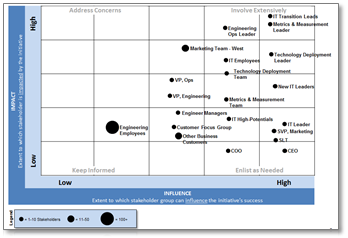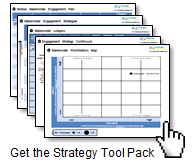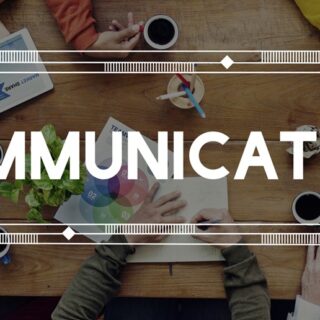
Stakeholder prioritization is one of the fundamental building blocks to a successful organizational change strategy. Too often, though, project teams get the stakeholder prioritization step wrong. Two of the most common stakeholder prioritization pitfalls are
- Prioritizing stakeholders based on the wrong assessment criteria
- Prioritizing stakeholders based upon input from too few people
To clarify, in the context of a change management initiative a stakeholder is any individual or group of people who
- Will be impacted by changes resulting from the business initiative, and/or
- Can influence the success of the business initiative
With this definition, it then makes good sense to think about stakeholder in terms of their impact and influence. This analysis is best done using a two-by-two Stakeholder Prioritization Map. To the right is an example of a completed stakeholder prioritization analysis using the map, where the size of the bubbles indicates relative size of the stakeholder populations.
The degree to which you should involve each stakeholder will depend upon where each ends up on prioritization map. Stakeholders in the upper-right hand quadrant are the highest priority and should be involved extensively in the organizational change effort. Stakeholders in the upper-left and lower-right quadrants should have their concerns proactively addressed and should be involved in the change effort as needed.
The stakeholder prioritization map will inform which Stakeholder Engagement Strategies use should use. Together, the prioritization map combined with the engagement strategies will help guide your development of appropriate strategies for each stakeholder group.
The stakeholder analysis process should not be done in a vacuum by just one or two people. Instead it should involve many people and take into account diversity of perspectives. Consider getting input from the executive sponsor, various members of the project team, business leaders from the affected areas, HR, Corporate Communications, and others as you deem appropriate. Build the stakeholder prioritization map and engagement strategies by reviewing them with each of these groups and adjusting it as needed.
 >> Download the Stakeholder Engagement Strategy Tool Pack to help you analyze and prioritize your initiative’s stakeholders, identify appropriate stakeholder engagement methods, and develop a tactical stakeholder engagement plan.
>> Download the Stakeholder Engagement Strategy Tool Pack to help you analyze and prioritize your initiative’s stakeholders, identify appropriate stakeholder engagement methods, and develop a tactical stakeholder engagement plan.
You may also want to check out How to Select Stakeholder Engagement Strategies, Nine Strategies for Overcoming Change Resistance, and How to Prioritize Stakeholders to Ensure a Successful Change Program.












2 comments
Pingback: How to Select Stakeholder Engagement Strategies «
Mike Clayton
at 11:53 am
Hi Jesse. Thank you for your kind comment on my blog.
Your readers may like to consider a variation to this tool that they can also use – similar, but rather than consider the impact on the stakeholders; this one divides stakeholders into those with a generally positive attitude to the change (supporters) and those who oppose it (detractors).
When these divisions are useful, I find that this leads to more clear-cut strategies. You and your readers can see this alternative approach in “Avoid Resistance”, here.
Mike Clayton
Author of the Handling Resistance Pocketbook
Buy it from Amazon.com